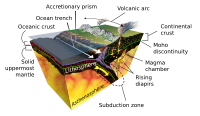
Photo from wikipedia
An Mw 8.2 earthquake affected on September 8, 2017 the Cocos plate beneath the Caribbean plate next to the transform contact with the North American plate across the Tehuantepec gap,… Click to show full abstract
An Mw 8.2 earthquake affected on September 8, 2017 the Cocos plate beneath the Caribbean plate next to the transform contact with the North American plate across the Tehuantepec gap, one of the two gaps that exist along the Mexican subduction zone offshore Chiapas. The epicenter occurred at a depth of 47 km and was associated with a highly steep normal fault parallel to the trench. The origin can be related to slab pull forces, dehydration processes and reactivation of outer rise faults. This earthquake produced positive changes in the Coulomb static stress, which would favor the development of thrust displacements along the interplate contact across the Tehuantepec gap instead of liberating tensions accumulated on it for decades. In the case that stresses were not released steadily in the future, a thrusting-related event with a magnitude of Mw 7.9 or higher could be expected after the September 8, 2017 Chiapas earthquake. However, the differential weight of the forearc offshore (that contains a region with a high positive gravity gradient) could inhibit rupture propagation to the coast precluding higher magnitudes. Combined and satellite only earth gravity field models show a highly heterogeneous density structure along the forearc of the North America-Caribbean plates and in particular at the studied zone. Maximum displacements in the rupture zone correlate to minimum gravity-derived anomalies showing a probable relationship between the differential weight of the forearc structure and the extensional faulting affecting the bending of the Cocos plate at depth. In this sense, variable sediment thicknesses over the forearc, and a high gravity gradient zone parallel to the trench in the outer forearc, could be reflecting physical heterogeneities that influence the propagation of the rupture zone. Additionally, to the north, a highly positive gradient signal related to the subducted Tehuantepec Fz projection beneath the North American plate marks the ending of the main slip patch acting as a barrier to the seismic rupture propagation. This event exemplifies (1) how extensional ruptures in the downgoing slab of a subduction zone can increment accumulated elastic strain across a seismic gap instead of liberating tensions, (2) that rupture propagation for this intraplate event was probably controlled (at shallow depths) by the density structure of the forearc, similarly to recent interplate earthquakes along the Chilean margin; (3) how a low gravity gradient signal and low density structures identified from the inversion model in the region of the outer forearc, where the normal stress increased after the main seismic event, suggest a higher risk of occurrence of a great megathrust earthquake.
Journal Title: Pure and Applied Geophysics
Year Published: 2018
Link to full text (if available)
Share on Social Media: Sign Up to like & get
recommendations!